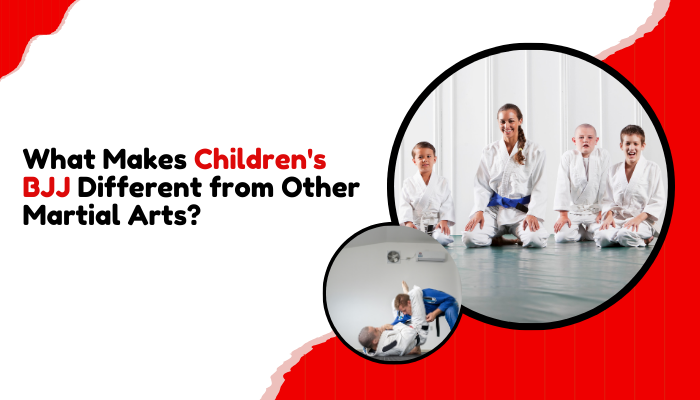Martial arts have long been a popular choice for children, offering discipline, fitness, and self-defense skills. Among the many styles available, children’s BJJ (Brazilian Jiu-Jitsu) stands out as a unique and effective martial art that focuses on technique over strength. While traditional martial arts like Karate and Taekwondo emphasize striking, children’s BJJ revolves around leverage, control, and ground-based techniques.
But what truly sets children’s BJJ apart from other martial arts? In this article, we’ll explore the key differences and why Brazilian Jiu-Jitsu is an excellent choice for kids looking to build confidence, discipline, and self-defense skills.
1. Children’s BJJ Focuses on Ground Fighting, Not Striking
Most martial arts, such as Karate, Taekwondo, and Kickboxing, focus on striking techniques—punches, kicks, and blocks. Children’s BJJ, however, is primarily a grappling art. Instead of relying on powerful strikes, kids learn takedowns, positional control, and submissions to neutralize opponents.
Why This Matters for Kids:
- Reduces the Risk of Injury – With no emphasis on punching or kicking, the chances of concussions and serious injuries are lower.
- Teaches Control Over Aggression – Children learn to handle conflicts through technique rather than force.
- Develop Strong Defensive Skills – Kids are trained to defend themselves without causing unnecessary harm.
By focusing on ground-based techniques, children’s BJJ allows smaller and weaker individuals to defend themselves effectively against larger opponents.
2. Problem-Solving and Strategy Over Strength
Martial arts often require physical strength, speed, and endurance. While these attributes help in any combat sport, children’s BJJ prioritizes intelligence and strategy. Kids are taught to think critically about their movements, anticipate their opponent’s actions, and apply techniques based on leverage rather than brute force.
Key Benefits of Strategic Thinking in Children’s BJJ:
- Encourages Patience and Problem-Solving – Kids must analyze their opponent’s movements and find the best way to escape or counter.
- Builds Confidence in Smaller or Weaker Kids – Because technique outweighs strength, children of all sizes can succeed.
- Improves Adaptability – Since no two matches are the same, kids learn to adjust their strategies in real-time.
Unlike martial arts that rely on strength and speed, children’s BJJ helps kids develop a tactical mindset, making them more effective both on and off the mats.
3. Children’s BJJ Encourages Live Training and Realistic Application
Many traditional martial arts rely heavily on pre-arranged movements, known as katas or forms. These routines help with discipline and coordination but don’t always prepare students for real-life situations. Children’s BJJ, on the other hand, emphasizes live sparring (rolling), allowing kids to apply techniques in real-time against resisting opponents.
Advantages of Live Training in Children’s BJJ:
- Teaches Practical Self-Defense – Kids learn how to handle real-world situations rather than just rehearsed movements.
- Builds Confidence in Physical Encounters – Regular sparring reduces fear and hesitation in self-defense situations.
- Helps Kids Learn from Experience – Every role teaches something new, reinforcing techniques through practice.
This hands-on approach makes children’s BJJ one of the most effective martial arts for realistic self-defense training.
4. A Supportive and Non-Aggressive Learning Environment
Many martial arts competitions reward aggression and powerful strikes. Children’s BJJ fosters a different atmosphere—one that promotes control, respect, and patience. The belt system in BJJ takes longer to progress through compared to other martial arts, emphasizing mastery rather than quick promotions.
Why This Environment is Beneficial for Kids:
- Encourages Cooperation Over Competition – Kids learn to work together to refine their techniques.
- Focuses on Respect and Sportsmanship – Training partners help each other improve rather than just compete to win.
- Teaches Resilience and Humility – Losing a match in sparring is part of learning, reinforcing perseverance.
Because of this, children’s BJJ is often seen as one of the best martial arts for fostering a positive mindset in kids.
5. Children’s BJJ Provides a Safe and Controlled Way to Learn Self-Defense
Many parents worry about martial arts encouraging aggression in their children. Children’s BJJ focuses on control, technique, and self-defense rather than attacking or harming an opponent.
Key Self-Defense Aspects in Children’s BJJ:
- Teaches How to Escape Dangerous Situations – Kids learn how to get out of holds, grabs, and ground positions.
- Builds Confidence Without Encouraging Violence – The goal is to neutralize threats, not provoke fights.
- Provides Bullying Prevention Strategies – Children gain the skills to protect themselves while remaining calm under pressure.
By training in a controlled environment, kids develop confidence in their ability to defend themselves without resorting to aggression.
6. Physical and Mental Benefits Beyond Martial Arts
Like all sports, children’s BJJ provides excellent physical benefits, improving strength, flexibility, and endurance. However, it also has mental benefits that set it apart from other martial arts.
Physical Benefits:
- Enhances Coordination and Balance – Constant movement and grappling improve overall body control.
- Increases Cardiovascular Fitness – Rolling and drilling build stamina and endurance.
- Strengthens Core Muscles – The techniques used in BJJ engage core muscles for stability and control.
Mental Benefits:
- Boosts Focus and Concentration – Kids must stay attentive to their opponent’s movements.
- Develops Emotional Resilience – Losing is part of learning, helping kids handle setbacks constructively.
- Encourages Goal-Setting and Discipline – Progressing through belt ranks teaches patience and perseverance.
Unlike striking-based martial arts, children’s BJJ challenges kids physically and mentally, making it a well-rounded activity.
In Ending
Children’s BJJ is more than just another martial art—it’s a system that teaches kids discipline, problem-solving, and self-defense in a safe and supportive environment. Unlike striking-based martial arts, BJJ focuses on ground techniques, live training, and strategic thinking, making it one of the most practical and engaging martial arts for children.
Brazilian Jiu-Jitsu offers an excellent foundation if you’re looking to help your child build confidence, develop self-defense skills, or stay active. If you want your child to experience the benefits of children’s BJJ, now is the perfect time to get started!
To read more blogs you can explore this website- insidetechie.blog



 :
:









